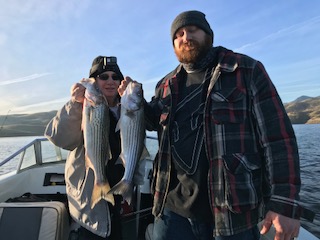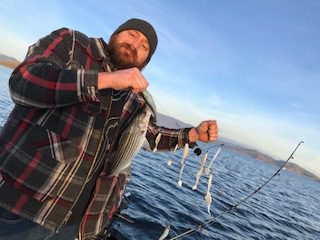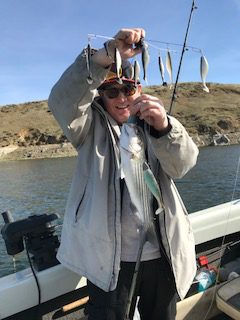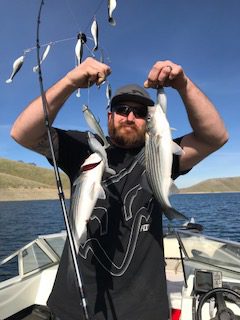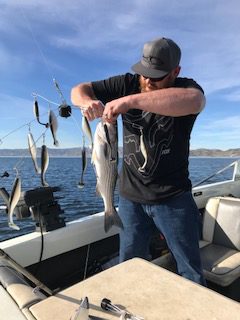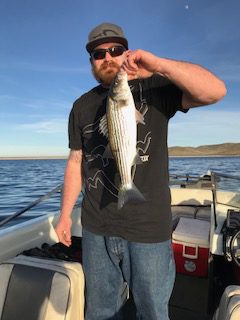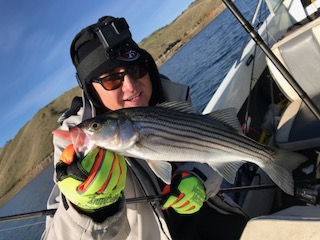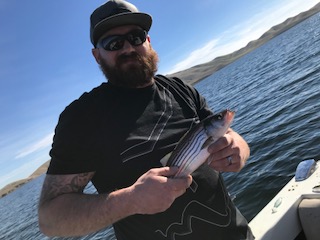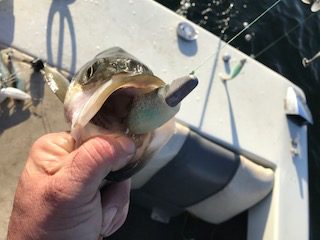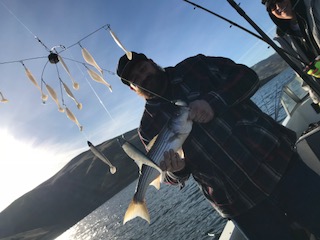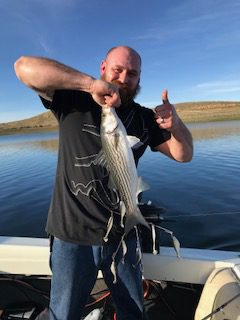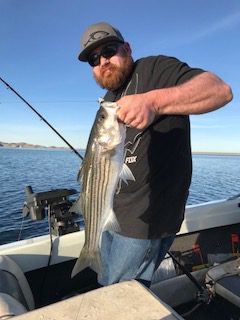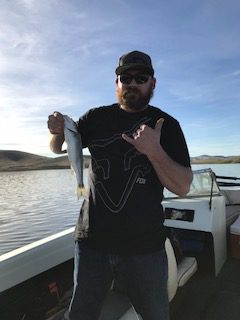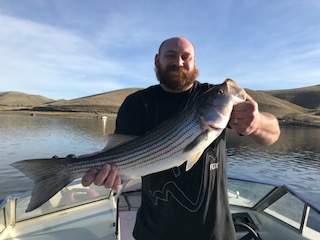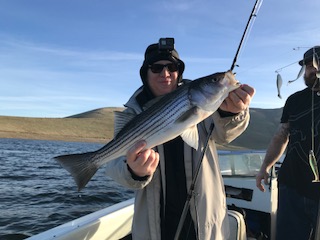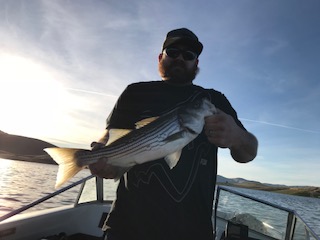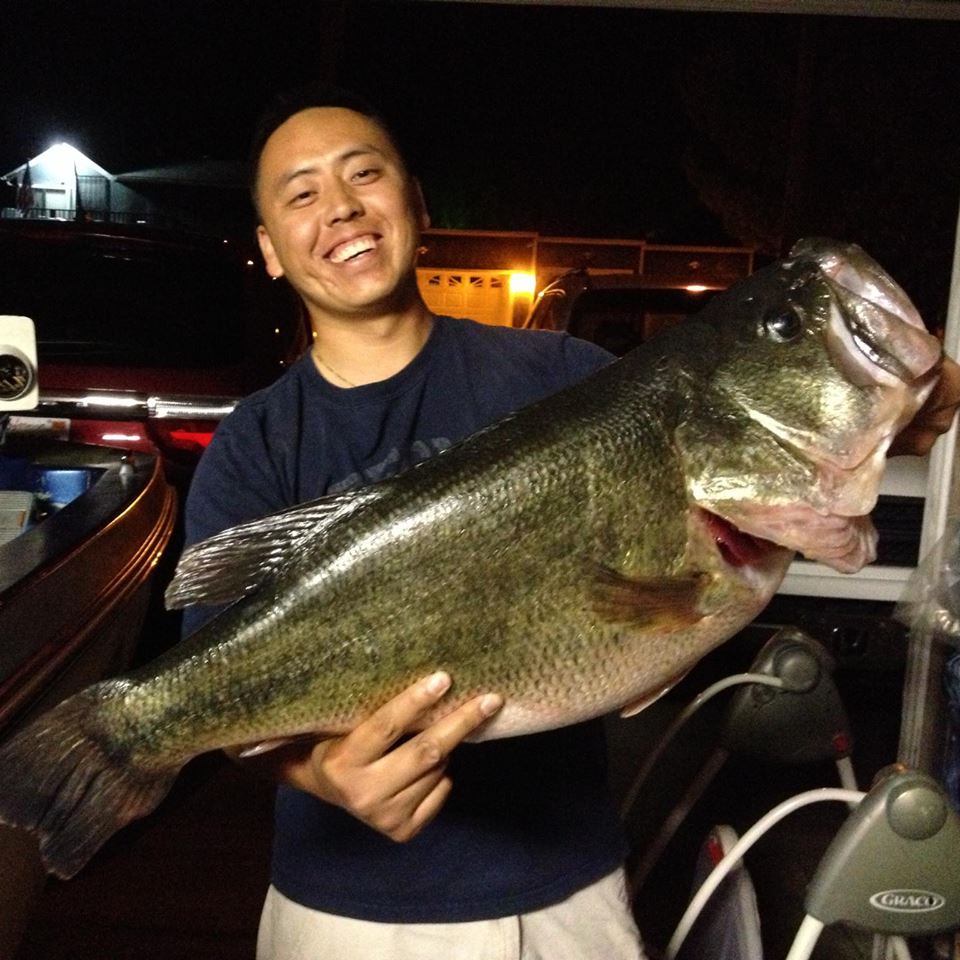
Fishing Report: San Luis Reservoir January 27, 2018
My last time out to San Luis Reservoir was two weeks ago and it was cold, cloudy and foggy. We didn’t do so good with only 8 catches. Fishing was slow.
Conditions yesterday were completely different. The sun was out, no clouds and it was warm in the afternoon. We managed 20 fish to 24″. Downrigging with the Atlas rigs have kept me consistent when fishing San Luis Reservoir. I’ll explain why in a bit but first how our trip went.
I went out with Daniel and David. We started our morning by the Basalt side. Fished in front of Fisherman’s Point in 80′-100′ of water. We landed a few there using the Atlas Rigs. The sun was starting to blaze down on the lake when we left the area for Lone Oak Bay. Ten to fifteen minutes into our first pass, we hooked into a nice fish. It was caught in 80′ of water. We didn’t mark much on the bottom at that depth so we trolled a little deeper. Finally around the 90′-100′ mark we spotted more fish on the bottom.
How I locate these fish is, I look for little bumps on my Humminbird fish finder. Most anglers, bypass these areas because they’re looking for suspended arcs. A far majority of the fish caught here are bottom feeders. They forage on the bottom for sculpin, grass shrimp or other bottom dwelling baits.
To catch fish here, you need to be on the bottom. That’s why it is important to know the depth of your rig.
It’s harder to fish the bottom using lures. A slight change in speed, elevation change or turn of the boat and you’ll be dragging debris. It’s easier to hook into debris with treble hooks.
That’s why I like using the Atlas Umbrella Rig in these areas. The arms act like a weedless guard in a way. Keeping the other swimbaits off the bottom. Plus the single hook is less likely to grab debris down there if you do happen to drag it on the bottom.
People stay away from trolling on the bottom because they have no clue how deep their rigs are. I’ve collected depth measurements and created depth charts on the Atlas Rigs so I know with confidence, exactly where the Atlas is when I troll the bottom. With a steady speed on a flat bottom, I can stay inches off the lake bed.
That knowledge is what makes the Atlas so effective for me.
Seeing the little bumps on my fish finder in this flat stretch 100′ deep, I trolled inches off the bottom for these stripers. It wasn’t a hot bite but we were consistent in catching these striped bass. After the striper bite slowed down, I decided to go explore the Dino area a little.
We stopped by one of the coves in 100′ of water and found nothing. I scanned the bottom and trolled in the shallower areas. Nothing.
We continued to the small dam with the same result. Not much going on in the deep. We spent more time than we wanted there so I decided to head back to Lone Oak and Portuguese area to see if the bite would pick up again.
We tried the same locations and wasn’t marking much. It seemed like the fish had moved on. We trolled into Portuguese and caught a double but nothing else to show for. Stumped, I decided to try the Basalt side later that afternoon.
We caught fish at our first location but didn’t mark much activity. Knowing how fish relate using your fish finder is key. Sometimes I’ll spot similar arc patterns on my fish finder and catch fish. After seeing the same arcs over and over. Then catching fish over and over. You know those type of arcs work. It becomes a pattern in a way.
We decided to troll shallower into the coves on the Basalt side. Just by chance, we rolled into an area at the mouth of the cove in 40-50′ of water. These fish were stacked 20′ from the bottom.
Our first pass through them we landed fish immediately. When I see these marks and we hook into fish, I’ll make multiple passes, back n forth. Every other pass we were hooking up.
On one pass, we had to stop the boat because Daniel snagged the bottom. Turns out, it was actually a fish that he hooked on the Atlas Rig. He broke his personal best twice that day with the striper.
This is your typical winter bite. A slow grind but you can still catch fish. I like fishing deep water because a high majority don’t target these depths. You know how I know because in the morning, the parking lot would be littered with parked cars and trailers. By late morning to afternoon, half of these boaters are gone and several more en route. This is usually the time when they move off the shallows.
Downrigging isn’t very popular because it’s a big investment. Imagine for a bit the amount of time and money invested into each fishing trip. The fishing reports you read, fishing buddy’s you call and forums you skim through to plan that trip. Then gasing up an empty tank on your truck and the boat to you can make it out there.
Investing in downriggers will help you save alot of that time and money. Pair the downriggers with a rig like the Atlas and you have the right tools to stay consistent each trip when you target stripers at San Luis Reservoir. The ability to fish all water depths is a game changer.
Now you know. Go get em!
You can find the same gear I use using the affiliate links below.
–Okuma Cold Water line counter reel
–Daiwa Wilderness Trolling Rod
–TackleBuilders Atlas Umbrella Rig

